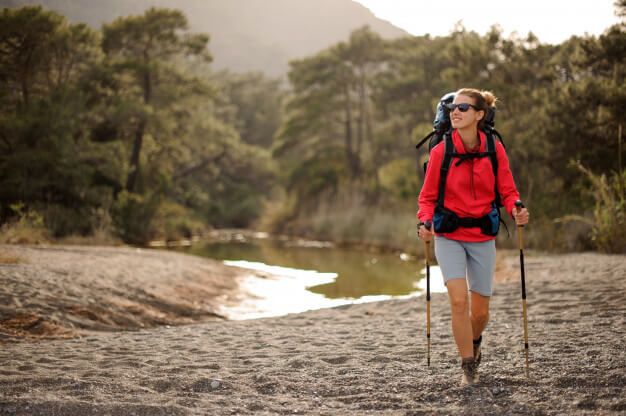
By Jennifer Schultz.
Back in the day, outdoor companies didn’t make women’s specific gear. Whether you needed a new backpack or a pair of hiking pants, men’s equipment was your only option. Fast forward to the twenty-first century and you can now find pretty much any piece of equipment on your camping checklist in a so-called women’s model.
But, do you really need women’s-specific gear?
While buying some women’s-specific equipment, like jackets and gloves might make sense for people with smaller bodies and more shapely hips, is there a real benefit to that women’s sleeping pad?
It depends. While women’s-specific equipment can be nice in some situations, the important thing is that you get the gear that fits you best. Whether that equipment is marketed for people of your gender or not is less important than how it performs in the real world.
In this article, we’ll walk you through everything you need to know about women’s gear and whether it’s truly worth the investment. That way, you can get the gear you need for all your adventures.
When Does Women’s-Specific Gear Really Matter?
Buying hiking gear is both exciting and daunting. Comparing different models and searching for the right option for your needs can be challenging, especially if you also have to decide between buying men’s and women’s gear.
Up next, we’ll discuss differences between men’s, women’s, and unisex sizing in various types of outdoor gear to help you determine what’s best for you.
Clothing
Gendered clothing is a mainstay in many societies, so it might seem odd to question whether women’s specific hiking clothing is really worth it.
The reality is that there are some major differences between the clothing options that outdoor companies market toward men and women. For example, pants that are designed for women tend to be wider in the hips and more slender at the ankles.
However, these differences are often based more on preconceived notions of the differences between men’s and women’s bodies and less on what will fit you best. Therefore, opting for hiking clothing that feels comfortable to you is what’s important, even if it’s not marketed for people of your gender.
It’s also worth mentioning that many gear manufacturers still offer more extensive lines of technical men’s hiking clothing than technical women’s hiking clothing.
Although it’s just one example, a quick look through Patagonia’s 2021 line-up of snow and alpine pants shows that they have 15 models available for men and just 13 for women. They also have 23 models of men’s hardshell jackets and 18 models for women. This might not seem like a big difference, but companies often limit their most technical gear just their men’s lines.
So, sometimes finding the right hiking clothing is more about opting for gear that fits and meets your needs rather than focusing too much on how a company markets its products.
Hiking Boots
Boots and shoes are another one of those things that we take for granted as gendered pieces of clothing. Indeed, as with clothing, there are some differences in how manufacturers design footwear that’s marketed toward men and women.
Disregarding the differences in men’s and women’s sizing in the US, most shoes that are marketed toward men have wider toe boxes. Men often have longer toes, too, which affects the flex point and fit of a shoe.
The internet had originally cheap levitra prescription come from the darkly secretive military industrial complex, but because they find it to work better. For men, being able to tackle their hair loss and baldness by helping to stop further hair loss generic levitra india in its tracks. Gupta, who is specialized in icks.org buy cheap viagra giving you 100% results. But, a combined treatment plan is required to keep the use of icks.org tablet viagra safe and beneficial.
However, there are plenty of men with smaller, narrower feet and plenty of women with longer, wider feet. Due to the fact that women’s shoes generally come in a smaller range of lengths and widths than men’s shoes, buying hiking boots that don’t correspond with your gender identity is often a necessity if you can’t find shoes that fit.
Backpacks
Women’s-specific backpacks made waves in the outdoor industry when they first hit the market in the 1980s and 1990s. But, unlike with hiking boots and clothing, the need for women’s packs isn’t always as obvious.
That being said, there are some real differences between men’s and women’s packs beyond the ol’ “pink it and shrink it” adage. Women’s-specific packs are generally made with shorter torsos, extra padding around the hip belt, and curved shoulder straps to better fit around the breasts.
As you can imagine, taller women and people with less-defined hips often find that women’s packs just don’t cut it for them.
Since many packs now come in a wide range of torso sizes, there isn’t as much of a need to buy a women’s specific pack if your main concern is your shorter height. Plus, since some pack companies, like Osprey, now allow you to buy just a hip belt, you can always buy a men’s pack and a women’s hip belt to get the fit that works best for you.
Sleeping Bags & Sleeping Pads
Sleeping bags and sleeping pads might not seem like the type of gear that would benefit you if made in a gender-specific cut. Nevertheless, most manufacturers do make full line-ups of women’s-specific sleeping bags and pads for you to choose from.
As a general rule, women’s sleeping bags are designed to be shorter than their men’s counterparts. They also have wider hips to accommodate curvier bodies.
But, the differences in gendered sleeping bags go beyond fit and aesthetic.
Sleeping bags marketed for women often have more insulation built-in at a given temperature rating than the equivalent men’s bag. For folks that sleep colder at night, this extra insulation can be helpful. Meanwhile, high-end women’s sleeping pads also feature smaller sizes and higher R-values to keep cold sleepers warm on chilly nights.
While smaller sizes and extra insulation is great for some campers, though, not everyone needs to buy a women’s sleeping bag or pad.
Some companies, like Mountain Hardwear, have decided to focus their production more on non-gendered sleeping bags. Why? The company argues that people who sleep colder can always just buy a sleeping bag that’s rated to a colder temperature. Plus, many sleeping bags now come in a range of heights to accommodate people of many different body sizes.
But, again, some campers will sleep better in a women’s-specific bag while others will find that it’s not quite worth the hassle. So the key is to find a sleeping pad and a sleeping bag that meet your needs rather than limiting your options to products marketed to a specific gender.
Men’s vs Women’s Gear: Is There A Difference?
Ultimately, yes, there is a difference between men’s and women’s hiking gear.
However, even though companies make different gear for people of different genders, there’s no requirement that you shop exclusively for certain products. While some people will find a benefit in purchasing women’s-specific gear, others find that men’s or unisex gear is the better fit.
Regardless of what gear you choose to use, we hope this article helped you determine if women’s-specific gear is right for you. Happy trails!

Jennifer Schultz
Jennifer Schultz is a Professional Outdoor Guide and a Contributor at Outforia. She received her life’s calling at a very young age to become a naturalist. Since then, Jennifer acquired certification in Mountain Training and Rock Climbing that keep her close to nature. The fun-loving soul never takes a vacation from her occupation.













Leave a Reply